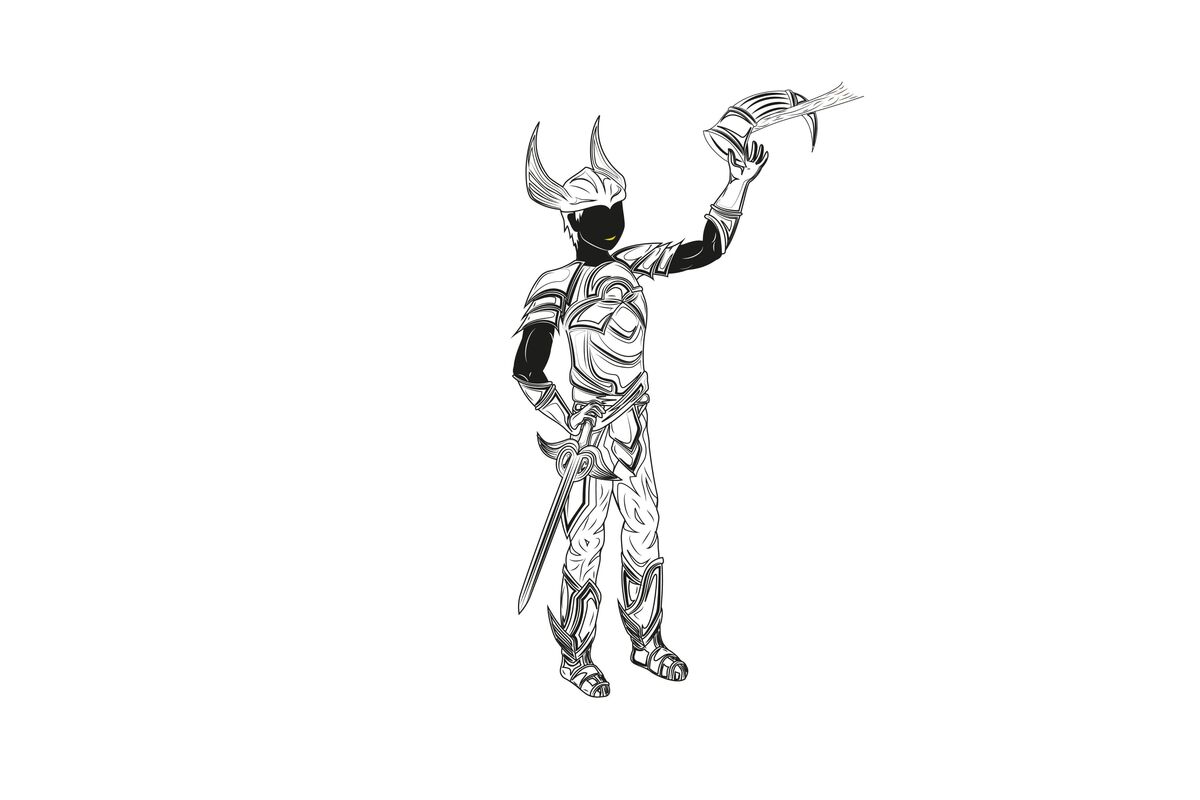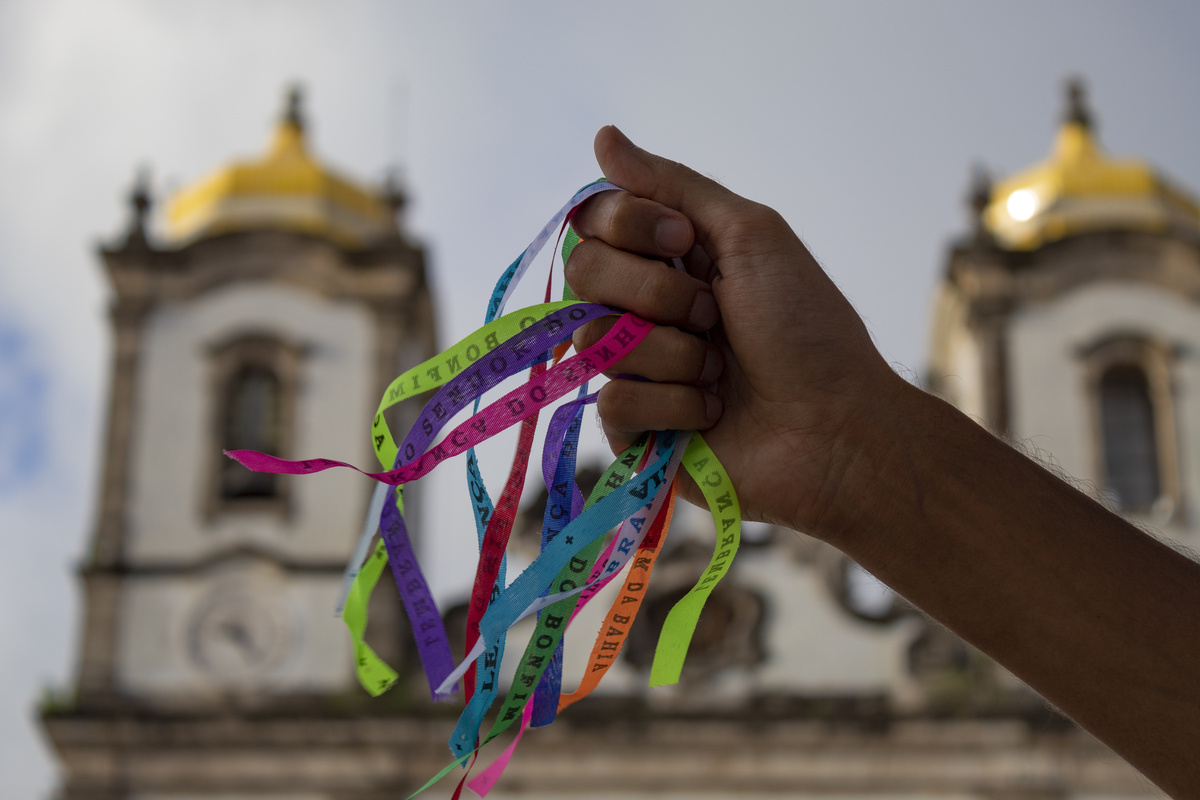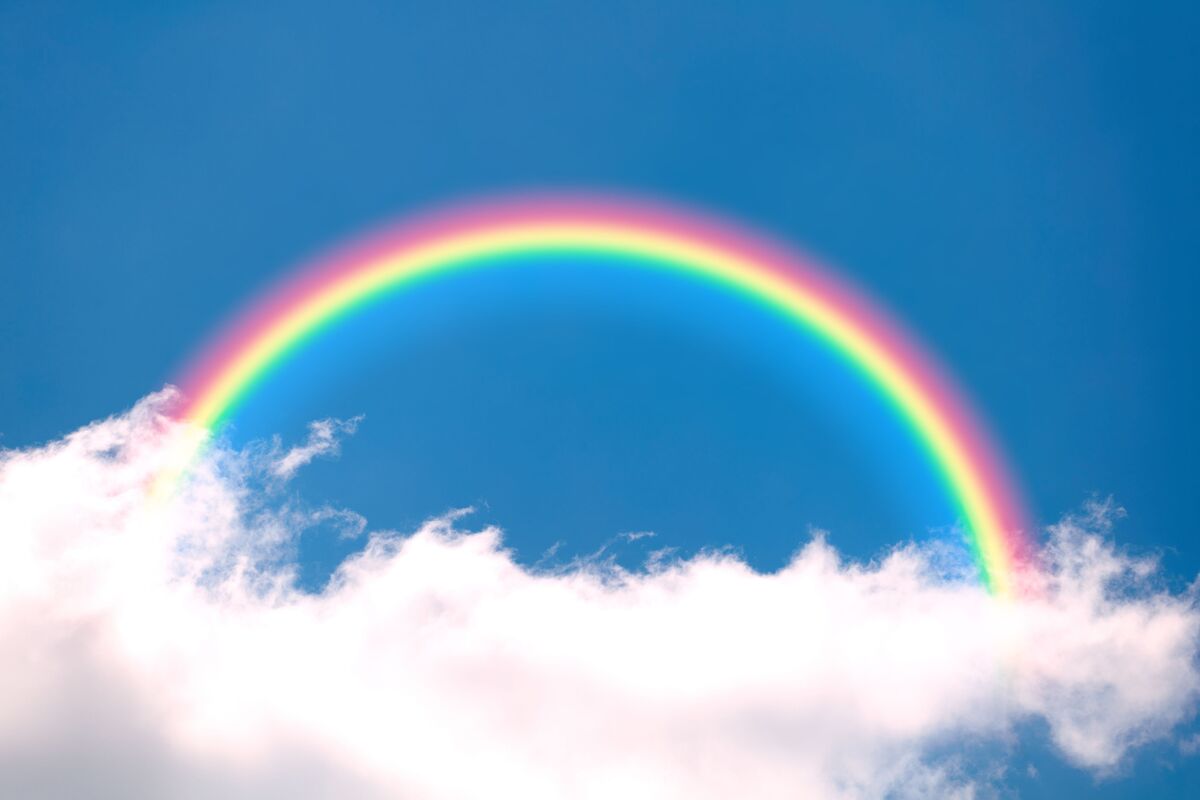Table of contents
Who is the orixá Oxumaré?

Oxumaré is the youngest son (depending on the version, he may have been the first) and favorite of Nanã, Orixá of the swamps, of the still waters and of the humid earth that offered the clay for the formation of humanity. He participated in the creation of the world by wrapping his body around all matter in order to reunite it in one form with his twin sister, Ewá.
His movements also designed the Earth, forming the landforms and waterways. Oxumaré also aids communication between our world and the spiritual world of the ancestors, and is also associated with the umbilical cord.
Through the myth of his winding himself up in the world, his mastery of the cycles of rain and fertility, and his communication with the ancestors, Oxumaré evokes the themes of cyclical renewal and the balance of life. Read on to learn more about this Orixà!
The history of Oxumaré

Oxumaré has a rich history, with two versions of his birth, besides being seen in unique ways in each faith of African origin in Brazil. Below, we will address these differences, the narratives and his relationship with the rainbow. Check it out!
Oxumaré in Umbanda
In Umbanda, it is common the syncretism of Oxumaré with Saint Bartholomew, patron saint of merchants, tailors, bakers and shoemakers. In some Umbanda lines, Oxumaré can be seen as a facet or a quality of Oxum, the lady of sweet waters and fertility.
He is the lord of the rainbow, of the cycles and of the rains, who maintains the order of the world, allowing everything to be reborn. Without Oxumaré, there are no cycles, and without cycles, there is no life.
Oxumaré in Candomblé
In Candomblé, Oxumaré is the Orixá of cycles and, therefore, maintainer of the natural order of constant transformation of the cosmos. He is also the Orixá of riches and can favor a long life.
In some lines of Candomblé, the masculine and feminine duality of Oxumaré is not very present, being more seen as a male Orixá. But, even so, he carries with him all the representation of the creative and moving potential of fertility.
Other lines divide Oxumaré between male Oxumaré, in the form of a rainbow, and female Oxumaré, in the form of a serpent. He can also be found in syncretism with the vodun Azaunodor, Frekuen, Bessen, Dan and Dangbé.
First version of his birth
During the creation of the world, Oxalá took a pigeon (or a chicken, depending on the version) to scratch some earth, spreading it around and creating the ground.
From the mixture of earth and water was born Nanã, to whom Oxalá married. From both were born the twins Oxumaré and Ewá, who, in the form of serpents, crawled out and gave shape to the earth. Afterwards came Iansã and Omulu (some say it was Obaluaê), who was born covered with sores and was abandoned by his mother, as was customary, but was welcomed by Iemanjá.
In this version, Nanã would also have abandoned Oxumaré because of his serpentine form, seen as a deformity. However, after being observed by Orunmilá who took pity on him, Oxumaré was transformed into a beautiful Orixá. By Orunmilá, he would also have received the task of taking the waters to heaven for Xangô.
Second version of his birth
And a second version of his birth, Nanã did not abandon Oxumaré, as soon as he was born. However, while still pregnant, she received Orunmilá, who prophesied that her son would be beautiful and perfect, but that he would not remain close to her, being always free and in eternal change, as punishment for having abandoned Omulu. Even so, with this fate sealed, Oxumaré would have become the favorite son ofNanan.
Oxumaré and the rainbow
Oxumaré is the Orixá responsible for the hydric cycle of evaporation and the condensation of the waters that fall in the world with the rains. In this way, he is also seen as the rainbow Orixá, who favors the continuation of life and the fertility of the earth.
This process occurs while Oxumaré is in his male form, which lasts six months. In the other half of the year, he assumes his more serpentine female form, linked to his movement through the earth.
It is said that Oxumaré disliked rainy days and chased them away so that he could see the rainbow. Yet he is charged with carrying the waters from the earth to the heavens through the rainbow so that the rains would come. His own name in the Yoruba language (Òṣùmàrè) literally means "rainbow.
Besides, another version tells that Oxumaré would have rendered services to Olokun, who wanted to get pregnant, but could not. Then, the Orixá guided her to make offerings, saying that, this way, she would have several children and all strong. She did so and what was said happened.
In gratitude, Olokun offered Oxumaré payment and also gave her a multicolored scarf. She said that whenever she wore it, a colored bow would be seen from the heavens.
The syncretism of Oxumaré

In Brazil, the best known syncretism with Oxumaré is with the Catholic saint Saint Bartholomew, but he is also seen as being related to other African entities and also has interesting similarities with deities from other Indo-European pantheons.
Saint Bartholomew for Catholics
In Umbanda, the syncretism of Oxumaré with the Catholic Saint Bartolomeu is one of the best known, being the patron saint of merchants, tailors, bakers and shoemakers.
St. Bartholomew was one of the twelve apostles of Jesus mentioned in the New Testament, though we don't have much other information from him in these texts. Some call him Nathaniel, as Bartholomew would come from etymology as "son of Talmay (or Ptolemy)," thus being a patronymic and not his first name.
Furthermore, historians suppose that he may have preached as far as India or the Caucasus region, where he was supposedly killed by flaying for trying to spread Christianity in the region. But beyond that, information about his life is hard to find.
Heimdall in Norse mythology
In the Norse pantheon, Heimdall is the guardian of the entrance to the realm of Ásgard, protector of the Aesir and of humanity. It is he who watches over and commands the rainbow bridge Bifrost, which connects the nine realms of Yggdrasill to one another.
Its origins are uncertain, as many sources were written centuries after the Scandinavians were converted to Christianity, and even among them, few made it in one piece into the 21st century. Some texts claim that Heimdall has nine mothers, but it is not known for certain what this would mean, nor who they would be, although theories do exist.
According to the poem Rígsthula, Heimdall is also the creator of the social classes of ancient Scandinavia. In the story, he wanders the land using the name Ríg, stays in three houses, and sleeps with the three women of each dwelling, each having given birth to the progenitors of the members of each class: the lords, the freemen, and the slaves or serfs.
In addition, it will be Heimdall who will sound the Gjallarhorn horn, to awaken the gods before the battle of Ragnarök and warn that the giants are approaching. According to Snorri Sturluson, it is planned that Heimdall will fight Loki in the final battle, in which one will kill the other.
Therefore, one can see the similarities between Heimdall and Oxumaré in terms of their roles as protectors and travelers between the worlds and for using the rainbow as a bridge between the planes. However, the similarities end there.
Still in the Norse pantheon, the similarity between Oxumaré, as the serpent that encircles the world, and Jörmungandr, a colossal serpent who is the daughter of Loki and Angrboda and who coils around Midgardr (the world of humans), is remarkable. When Jörmungandr moves, we feel tremors and great waves and storms arise.
In addition, similar visions are associated with Oxumaré, for it is believed that if he stops circling the Earth, it would lose its shape and fall apart. But, once again, the similarities end there, especially because Oxumaré is an Orixá of order and life, while Jörmungandr has a more chaotic aspect.
Iris in Greek Mythology
For the Hellenic pantheon, Iris is the goddess of the rainbow and the messenger of the gods of Olympus. According to Hesiod's Theogony, she is the daughter of Thaumas, a sea god, and Elektra, a cloud nymph (not to be confused with the mortal Electra, daughter of Agamemnon), and is therefore the daughter of a union of the heavens with the waters of the world.
In mythology, she was depicted as a beautiful maiden with golden wings, a kerykeion (a type of staff) and a jug of water in each of her hands. She was sometimes syncretized in the arts with Hebe, daughter of Zeus and Hera.
For the Greeks who lived in coastal regions, Iris carried the waters of the sea through the rainbow to supply the clouds with rain, since, in their vision, it was as if the arc touched the heavens and the waters at the same time.
But, in Homer's texts, Iris is not the goddess of the rainbow, as her name would be used to speak of the arc itself, being she a personification. "The Odyssey" also does not mention the goddess as a messenger, being Hermes the communicator of the Olympian gods, despite being present in "Iliad", in the service of the divine royal couple.
As the centuries passed, Iris increasingly assumed the role of messenger, but more specifically of Hera than of all Olympus, for this domain never ceased to be Hermes'. Another concept reinforced in later years was that she would use the rainbow to travel, making it vanish after it was no longer needed.
Furthermore, she did not have a cult or mythologies (a set of stories) of her own, except at Delos, where some devotees of Hecate seem to have offered her oatcakes during rites.
So Iris was not syncretized to Oxumaré at any point in history, any more than Heimdall was, but it is still amazing to see the similarities between the two deities, especially in their use of the rainbow for travel, their connections between heaven, earth, and water, and the stories about supplying rain clouds with water through the rainbow bridge.
The qualities of Oxumaré

Besides the syncretism with Saint Barthelemy, Oxumaré was also associated with other African entities, from other cultures close to the Yoruba and that were brought to Brazil, such as the Jejê, the Ketu, the Fons and many others.
Especially in Candomblé, more connected to African aspects and without significant mixtures with Christianity or Spiritism, Oxumaré has been linked to other voduns - nature spirits with specific powers. So, read on to learn more!
Vodun Azaunodor
Some say that the Vodun Azaunodor is a princely aspect of Oxumaré, linked to the past and the ancestors. According to religions, this quality or facet of the orixá lives in the baobab, the ancestral tree of the African peoples of the region.
Dan
In the Jejê culture, Oxumaré would correspond to Vodun Dan or Dã, originally from the Maís region. Like the orixá Oxumaré, Dan is the cyclical movement that guarantees the continuity of life and strength. In addition, this facet is represented by a colorful serpent that bites its own tail and also acts as protection for other voduns.
Vodun Frekuen
According to the religions of African matrix and different from the constructive, ordering and balanced aspects of Oxumaré or his Dan facet, Vodun Frekuen would be a poisonous serpent, associated with his feminine side.
Vodun Dangbé
While some sources say that Dangbé is another name for Dan, one of the qualities of Oxumaré, others claim that he is a more ancestral Vodun, being Dan's father and also part of the Jejê culture.
Therefore, he would be the one who guides the movement of the stars, as well as a very intelligent entity. Dangbé would also be calmer than Dan, being subject to fewer changes than his son.
Vodun Bessen
Bessen is a warrior aspect Vodun of Oxumaré, being ambitious, but also generous. Like his other facet, Azaunodor, he is linked to the color white and is worked with him especially in the Bogun terreiro. According to the religions of African matrix, Bessen is seen as the warrior aspect of the orixá Oxumaré.
Characteristics of sons and daughters of Oxumaré

As for the children of Oxumaré, their characteristics vary from source to source. Some say that because the Orixá is very beautiful and envied, his children would also care a lot about appearance and beautiful things, but another very present trait is his generosity to those who need help or are in need.
Besides, another common point is their changeable personality, almost volatile, being able to go from one side to the other quickly. Want to know more? Keep reading!
Always looking for the new
Just as Oxumaré changes form constantly, always bringing the end of one cycle and the beginning of another, his children are people who are always looking for new things. They never stay stuck in one situation, activity, or position for too long.
In addition, their emotional cycles can also undergo constant change. Not that they are stingy or immature by any means, but when they feel they have learned all they have to learn from that person or situation, they move on in search of the new learning and challenges of life.
For them, just like their orixá, change must always occur. A static world is a dead world and they understand this better than anyone else.
Constant activity
The constant movement of the children of Oxumaré does not apply only to people and situations. Rather, it expands to many areas of life, even in small matters like the way they spend their time throughout the day.
The children of this Orixà are people who always need to be doing something. This is something they have to be careful with, so that they do not reach exhaustion.
Warrior Personality
The children of Oxumaré never hesitate in the face of a challenge. The born warriors that they are, they don't measure efforts to get what they want once they get their minds set on something. These people are extremely determined and fair, and will certainly fight to defend themselves, the needy, and their goals.
To relate with Oxumaré

If you are a son of Oxumaré or if you just felt touched by his history and symbolism and now want to know more about how to get in touch with this Orixá, keep reading! Soon below we will talk about his commemorative dates, offerings, greetings and more!
Day of the year of Oxumaré
The day of celebration of the orixá Oxumaré occurs on August 24. On this date, it is possible to take an herbal bath, seeking balance and cleansing, and present offerings to him, asking that the cycles that are no longer useful be closed and that new paths be opened.
Oxumare's day of the week
For the religions of African origin, the day of the week consecrated to the orixá Oxumaré, both in Candomblé and Umbanda, is Tuesday. Therefore, if you are looking for more frequent communication or offerings with this orixá, this is the ideal day.
Salutation to Oxumaré
Across the African faiths, we can find some variations in the greetings to the orixá Oxumaré, although they still remain similar. In Umbanda, for example, it is common to find the greeting "Arribobô!", while in Candomblé, the greeting can be "A Run Boboi!
Oxumaré Symbol
Representing the deity Oxumaré, the most well-known symbols used in Brazilian religions are the rainbow, the snake, the ebiri, the circle and the brajás (these are strings of beads worn by their babalaôs).
Colors of Oxumaré
According to religions of African origin, the colors of Oxumaré are green, yellow or a combination of the colors of the rainbow. In Candomblé, there are also those who use the color black instead of green. These colors are generally present on necklaces made of beads or beads that the children of Oxumaré wear.
Element of Oxumaré
In Umbanda, the orixá Oxumaré is linked to the element of water, while for Candomblé practices, we can find associations of the orixá with the sky and the earth, these being considered as elements.
Prayer to Oxumaré
There are several prayers and points that can be sung to the orixá Oxumaré. The following prayer was written by Alexandre de Yemanjá, Marcelo Ode Araofa:
"Òsùmarè e sé wa dé òjò
Àwa gbè ló sìngbà opé wa
E kun òjò wa
Dájú and òjò odò s'àwa
Asè.
Òsùmàrè is who brings us the rain
We receive it and return it gratefully
It's enough rain for us
Surely your rain is the river
Surely your rain is the river for us.
Axé."
Besides, there is another song made for him, coming from Candomblé. Check it out:
"Osumare remains in Heaven which he crosses with his arm
He makes the rain fall on the earth
He seeks the corals, he seeks the nana beads
With one word he examines Luku
He does this before his king
Boss whom we love
Father comes to the courtyard that we may grow and have life
He is vast as the sky
Lord of the Obi, you only have to eat one of them to be satisfied
He comes to the forest and makes noise like rain
Ijo's spouse, the indigo grove has no thorns
Ijoku's husband, who watches things with his black eyes"
Finally, another prayer to the orixá, taken from Juliana Viveiros' text, is as follows:
"Arrubombô Oxumaré Orixá,
Axé agô mi babá, agô axé, salve
Beloved snake of Daomé,
Hail the seven colors that reveal you in the sky,
Save the water, save the land,
Snake of Dan, protect me, Lord,
Of the motion of the stars,
Of the rotation and translation of everything,
What is born, what is transformed,
Oxumaré, you who are
Ouroboros and God of Infinity,
Be multiplied, by which my sweat shall become wealth,
May I win and may no one oppose me,
I believe in you, Babaê,
I know I'm already winning!"
Offerings to Oxumaré

One of the most common ways of relating to the orixás is through offerings, which can be of herbs, food, drinks or decorations. For Oxumaré, the usual thing is to offer sweet potato (there is the dish adimu, a stew with this potato, dendê palm oil and beans), green beans with eggs, mineral water and yellow flowers.
However, it is worth remembering that all offerings should be made with the help of a priest, whether from Umbanda or Candomblé, to know the correct ways to make them and the appropriate moment. Even so, keep reading to find out what Oxumaré can help you in your life!
For professional life
Being an orixá of riches, Oxumaré would certainly be favorable for requests to seek employment or better pay. His warrior aspect can also be called upon for difficult and tiring jobs, for which we need strength to continue.
In addition, its cyclical side can also be called in requests for the end of an exhausting job or one from which one feels he has already withdrawn all he can. But it can also open paths to a new job, without the individual being helpless.
For personal life
Aspects of offerings to Oxumaré can be reinterpreted for requests around personal life. If you seek a life of riches and beauty, you can ask him. The strength he calls can also help you persist in all areas of life, just as his cyclical side can help you make the changes you need.
In addition, following his myths, it may also be possible to ask Oxumaré for help with fertility and pregnancy, just as Olokun did, calling upon the orixá in his aspect as the maintainer of nature's fertility.
What does Oxumaré, deity of the rainbow, have to tell us?

The orixá Oxumaré teaches us the mysteries of the cycles of life. Just as he changes form every six months, the Earth and we ourselves must change. Nothing in life must be stagnant or there will be no life.
In addition, his beauty also draws our attention to the very beauty of nature, the heavens, the waters, the rain and the rainbow of this Orixá.
In this way, Oxumaré's persistence and warrior-like personality also speaks to how we should always keep moving forward, fighting for what we want despite all the odds, just as he and his children do.

